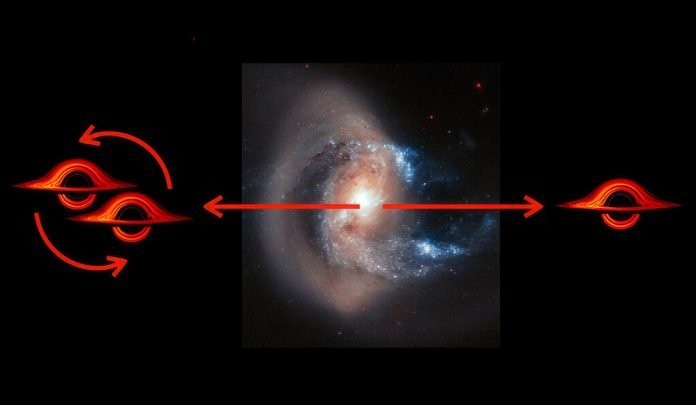
Astronomers say they may have found evidence of a “runaway” black hole, a discovery that would prove a theory that originated five decades ago.
Yale astronomers are on the lookout for a “runaway” black hole — a supermassive black hole that was catapulted away from the center of its host galaxy by the gravitational force of multiple black holes interacting at once.
A trail of a potential rogue black hole was detected in Hubble Telescope images of an unrelated foreground galaxy, the researchers say.
If confirmed with further observations, the discovery would prove a 50-year-old theory predicting the existence of runaway black holes.
“This was a bit of serendipity,” said Yale’s Pieter van Dokkum, lead astronomer for the multi-institution research team.
“We noticed an almost straight line of light in the Hubble images that pointed to the heart of a galaxy. As we had never seen something like that before, we decided to investigate it a month later with the Low-Resolution Imaging Spectrometer on the Keck I telescope.”
In a new study to be published in the Astrophysical Journal Letters, the researchers suggest that three black holes came together about 40 million years ago in the aftermath of the collisions of their host galaxies.
Due to the strong gravitational forces unleashed by this galactic pileup, one of the black holes ended up speeding away from the scene of the “accident.”
The line of gas and stars that the researchers spotted in the Hubble image — which is 200 light years long — would be the “wake” of the runaway black hole. Its endpoint is a bright point of light, which may be where the runaway black hole is located.
The mass of the black hole, the researchers said, is estimated to be as much as the mass of 10 million suns, and it is racing through space with a velocity of 4 million miles per hour.
The notion of a runaway black hole originated in the 1970s, as researchers considered the implications of galaxy collisions on the formation and evolution of black holes.
“It was very exciting to piece this puzzle together,” said van Dokkum, the Sol Goldman Family Professor of Astronomy and professor of physics in Yale’s Faculty of Arts and Sciences, who is first author of the new study.
“Even though Hubble has been around for many years now, it can still find entirely new phenomena in the night sky.”
The researchers note that further research — including through use of NASA’s James Webb Space Telescope and Chandra X-ray Observatory — will be necessary to confirm their findings. They also acknowledge the possibility of other interpretations for the discovery as they continue their research.
Written by Jim Shelton.



